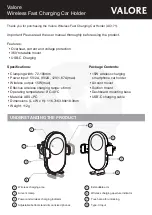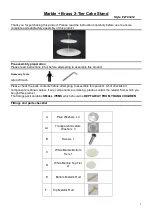
Wrap loose terminal blocks well with insulating tape.
This product must be connected to Earth.
The bulkhead light (PIR version) incorporates a Passive
Infra Red sensing device which continuously scans a
preset operating zone and immediately switches the
lamp on when it detects movement in that area.
While there is movement within range of the unit the
lamp will remain on.
You are advised at every stage of your installation to
double-check any electrical connections you have
made. After you have completed your installation there
are electrical tests that should be carried out: these
tests are specified in the Wiring Regulations (BS7671)
referred to in the Building Regulations. If in doubt,
consult a qualified electrician.
Where to Fit Your Ceiling Light
To achieve best results, we suggest you take into
account the following points:
• For maximum detection range, the bulkhead light
should be mounted 1.8 to 2.5 meters (6 to 8ft)
above the area to be scanned.
• To avoid nuisance triggering, the sensor should be
directed away from heat sources such as heaters/
radiators, air-conditioning outlets, other lighting, pet
entry/exit or sleeping areas etc.
• To avoid nuisance triggering, do not connect to
the same circuit as large fluorescent light fittings,
bathroom fans or other sources of mains borne noise
(peaks and spikes).
• The PIR Sensor scanning specifications
(approximately 8 meters at approx. 120° - horizontal)
may vary slightly depending on the mounting height
and location. The detection range of the unit may
also alter with temperature change. Before selecting
a place to install your new fitting you should note
that movement across the scan area is more effective
than movement directly toward or away from the
sensor. If movement is made walking directly towards
or away from the sensor and not across, the apparent
detection range will be substantially reduced.
Installation
1. Choose the location for your new fitting according
to each of the conditions above.
2. Turn out the three clips at the side of the diffuser
and lift off.
3. Remove the tube from the fitting by pulling straight
up.
4. Undo the gear tray retaining screw next to the PIR
detector module on the gear tray.
5. Undo the screws at each end of the hinge and lift
off the gear tray – take care not to lose the screws
and washers.
6. Choose whether you need to use 2 or 4 screw
holes and clear through using a 4-5mm diameter
drill.
7. Using the back of the fitting as a template, mark
the position of the fixing screws on your mounting
surface.
8. Prepare your fixing holes as appropriate.
9. Pierce the cable entry gland making a hole just
large enough for the cable to pass through and so
that the gland makes a tight seal around it.
10. Thread your supply cable through the gland.
11. Secure the back of your new fitting using suitable
fixings (not supplied).
12. Fix the gear tray by the hinge only, back into the
fitting using the screws and washers removed
earlier.
13. Allow the gear try to hang open.
14. Make the electrical connections according to the
colour code above.
15. Close the gear tray and secure with the screw
removed earlier.
16. Re-fit the lamp pressing firmly onto the
lampholder. Take care to position the lamp
correctly.
17. Replace the diffuser, take care to position the inside
rim of the diffuser over the circumference of the
rear half of the fitting and the soft seal around the
hole in the diffuser over the PIR detector lens.
18. Restore the power and switch on.
See installation diagram on page 4.
Installation Instructions and Care
3
























